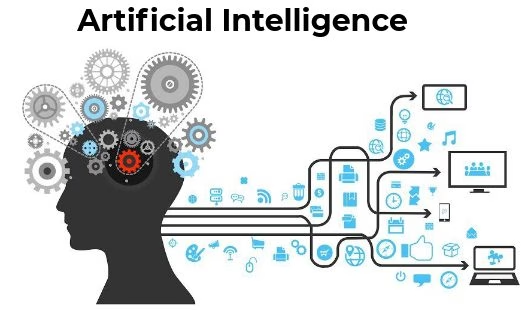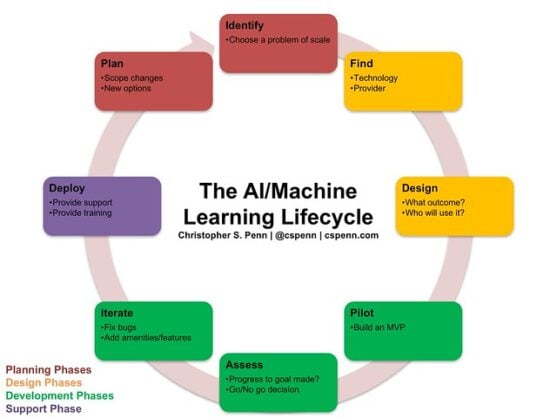
What is the AI Software Development Life Cycle?
Are you interested to know what the AI software development life cycle is? What are the 11 stages of the AI project cycle? And what is SDLC in AI?
Let's discuss this in detail!
What is the AI Software Development Lyfe Cycle?
The AI Software Development Life Cycle, or AI SDLC, is a process that helps software developers and development teams build and deploy software applications using AI(Artificial Intelligence).
What is the AI life Cycle?
The AI life cycle is a process that helps businesses solve their problems and improve business operations by using AI-powered solutions and tools.
In this article
- AI Software Development Life Cycle
- Planning to Launch an AI Solution?
- FAQs on AI Software Development Life Cycle
The AI technology market is big. It totaled $200 billion in 2023 and is projected to exceed $1.8 trillion by 2030.
If you're reading this article, you're likely planning to build an AI-powered solution. If so, you need to understand the AI software development life cycle. In this article, I will describe 11 steps you need to take to create an AI solution.
AI Software Development Life Cycle

The life cycle of an AI development project is as follows:
1. Identify
There are many exciting technology innovations; however, your business/organization has its core functions to discharge, and not just jump into every technology bandwagon! While AI has transformative potential, you need to know why you would use it.
Having clarity on this is the very first step. You can‘t achieve this clarity by just imposing AI in a top-down manner from the beginning.
In every business or organization, the people who serve the customers are on the frontline, and they have a first-hand view of where the organization needs to transform.
While the high-level decision-making of where to use AI rests with the senior leaders in an organization, the input for this must come from the people who serve the customers.
This will make the application of AI in your business meaningful. You need to have a project manager (PM) available full-time during this stage.
2. Find what you will automate
A clarification first! AI isn‘t automation as we traditionally understand it, and in fact, AI is very different from rule-based automation. Rule-based automation involves programming the automation of a task based on a set of rules.
On the other hand, AI involves computer systems learning from experience and performing the task better in an automated manner.
Notwithstanding the difference between the two, you are likely considering AI to automate parts of your business processes or organizational functionalities.
You want to realize greater value than what rule-based automation can provide, and that‘s why you are planning to implement AI.
What do you automate, though?
This is a key question since your objective is to unlock greater opportunities or to improve your organizational efficiency. Your people are still very valuable, and you want them to work on the real value-added stuff.
This calls for a careful identification of tasks you will automate with AI, thus enabling your skilled personnel to work on what shouldn‘t be automated.
You need the PM and a software architect in your team at this stage.
3. Plan the data sets for your proposed AI solution
AI needs data. That‘s a given; however, which data should you use to train your AI system? This question is very important since the appropriate selection of data sets is what will give you the best value from your AI solution.
Should you feed as much data to your AI or ML algorithms as you can? Well, that might sound attractive since the algorithms have more data to “learn” from. However, in practice, that‘s not always the correct approach!
Most businesses don‘t have clarity about much of their data, and in such cases, feeding data to AI/ML algorithms will not deliver optimal value.
You need to use the “Data Science Hierarchy of Needs,” created by Monica Rogati, an equity partner at Data Collective.
In this hierarchy, the first level is to collect data from relevant sources. The organization needs to store this data securely; subsequently, it needs to explore and transform it. They need to then aggregate and label it, followed by optimization.
The organization should then feed the resultant data sets to the AI/ML algorithms. This ensures that your proposed AI system has the right data to “learn” from.
You need data modeling experts along with the PM and software architect at this stage of your AI software development lifecycle.
4. Identify the AI capabilities you need
AI isn‘t monolithic. The tremendous value that AI creates comes from various AI capabilities, and your proposed AI solution might need several of them. You need to study the following AI capabilities and choose the ones you need:
- Machine Learning (ML): This includes deep learning, supervised algorithms, and unsupervised algorithms.
- Natural Language Processing (NLP): This encompasses content extraction, classification, machine translation, answering questions, and text generation.
- Expert systems are another key capability.
- Vision: This includes image recognition and machine vision.
- Speech: Speech-to-text and text-to-speech are included in this capability.
Planning and robotics are other key AI capabilities.
At this point, your development team should consist of the PM, the software architect, data modeling experts, and an AI/ML solution architect.
You should also create a Rough Order of Magnitude (ROM) estimate for the project so that you can get the necessary approvals from the project sponsor.
5. Agree on the right SDLC model for the project
A software development project to develop an AI solution is strategic since it addresses high-value objectives. Finalizing the requirements upfront is essential here since the scope creep later in the cycle will be costly.
The Waterfall SDLC model is the right one for such projects. It stresses carefully baselining the requirements before the design starts. Moreover, this model facilitates timely reviews of the project after key phases.
Read more about the Waterfall model in “What is software development life cycle and what do you plan for?”.
This model has the following phases:
- Requirements analysis;
- Design;
- Development;
- Testing;
- Deployment.
6. Requirements analysis
You need to onboard business analysts in your team at this point so that the requirements analysis phase can start. While you ought to follow the industry-standard requirements analysis processes, there are a few best practices for AI development projects.
Business analysis should consider the following factors while analyzing the requirements for an AI solution:
- Customer empathy;
- Experiments;
- The AI solution should be consisting of smaller components;
- Avoiding bias arising from wrong data.
7. Software Design
The next step in the AI software development process is the design phase, this is very time consuming and will require the AI development lead.
Assuming you are planning to launch the app on the web, Android, and iOS, you need the corresponding development leads. The test lead and the DevOps lead need to participate as well.
This phase involves the low-level design of the AI solution, and the architects and development leads need to work on various aspects like the process stages, sources of information, the conditions for target actions, dynamic behaviors, etc.
AI development platforms can expedite the project since they offer the following:
- AI capabilities like ML, NLP, expert systems, automation, vision, and speech;
- A robust cloud infrastructure.
During this phase, you need to evaluate the various AI development platforms, e.g.:
- Microsoft Azure AI Platform;
- Google Cloud AI Platform;
- IBM Watson AI platform;
- BigML;
- Infosys Nia.
You can read “The best artificial intelligence software development tools” for more insights.
8. Development
You need your complete software development team ready before starting this phase. Therefore, you need to induct your AI developers, web developers, and mobile developers. Given the complexity of creating AI neural networks, I recommend that you onboard a field expert development team, as I explained in “Freelance app development team vs. field expert software development teams.”
Different AI development platforms offer extensive documentation to help development teams. Depending on your choice of AI platform, you need to visit the appropriate web pages for this documentation, which are as follows:
- Microsoft Azure AI Platform;
- Google Cloud AI Platform;
- IBM Watson Developer platform;
- BigML;
- Infosys Nia resources.
9. Testing
Onboard your software testing and DevOps teams before this phase, and look for testers with experience in AI and ML systems.
While the fundamental testing concepts are fully applicable in AI development projects, there are additional considerations, too. These are as follows:
- The volume of test data can be large, which presents complexities.
- Data validation is important because human biases in selecting test data can adversely impact the testing phase.
- Your testing team should test the AI and ML algorithms, keeping model validation, successful learnability, and algorithm effectiveness in mind.
- Regulatory compliance testing and security testing are important since the system might deal with sensitive data. Moreover, the large volume of data makes performance testing crucial.
- You are implementing an AI solution that will need to use data from your other systems. Therefore, systems integration testing assumes importance.
- Test data should include all relevant subsets of training data, i.e., the data you will use for training the AI system.
- Your team must create test suites that help you validate your ML models.
10. Deployment
You should take into account certain considerations when deploying AI/ML systems, and these are as follows:
- The project team needs a robust internal handoff process between the IT operations and the development teams. Considering that AI/ML is new to several organizations, the operations team needs to have a sufficient understanding of the development project.
- Deploy the AI/ML solution as a centralized service that the entire organization can tap into.
11. Maintenance
This includes post-deployment support, warranty support, and long-term maintenance. You need to have a part of your software engineering team available during this phase since this will help the maintenance team learn the system. AI tools can also greatly help ease the burden on your team.
Planning to Launch an AI Solution?
This guide to the AI development lifecycle will help. However, such projects are complex. To create a new project, you will need a team with all the appropriate project management, architecture, development, testing, and DevOps expertise.
You should consider engaging a reputed software development company's software developers, so why not take a moment to fill out our project specification form to see if we can help you?
DevTeam.Space's developers are skilled in all the latest programming languages and AI tech stacks, including LISP, Python, TensorFlow, etc., and have experience developing robotic process automation or RPA, and other machine learning solutions.
FAQs on AI Software Development Life Cycle
It is the development cycle to create AI solutions. It includes 3 parts:
• Project scoping
• Design
• Build phase
• Planning
• Requirements
• Design
• Development
• Testing
• Deployment
• Maintenance.
The answer really depends on your project scope and your development priorities. Generally speaking, Agile is preferred by software programmers due to its time and flexibility focus.
Related AI Software Development Articles
Learn more about AI software development from our expert articles:
- How to Interview and Hire AI Developers (scroll down to read the article)
- What are the types of AI?
- What are AI Development Tools?
- 10 Real Life Examples of AI Use Cases
- How To Create an AI SaaS Product
- Top 10 Machine Learning Algorithms 2025
- 7 Best AI Software Development Tools in 2025
- 10 Best AI Apps in 2025
- 10 Best AI Tools Of 2025
- How Is AI Transforming the Product Development Process?
- How Can an Enterprise Use Predictive Maintenance AI?
- The Pros and Cons of AI
- 5 Ways Utilizing AI in Business Processes will Revolutionize Your Business


